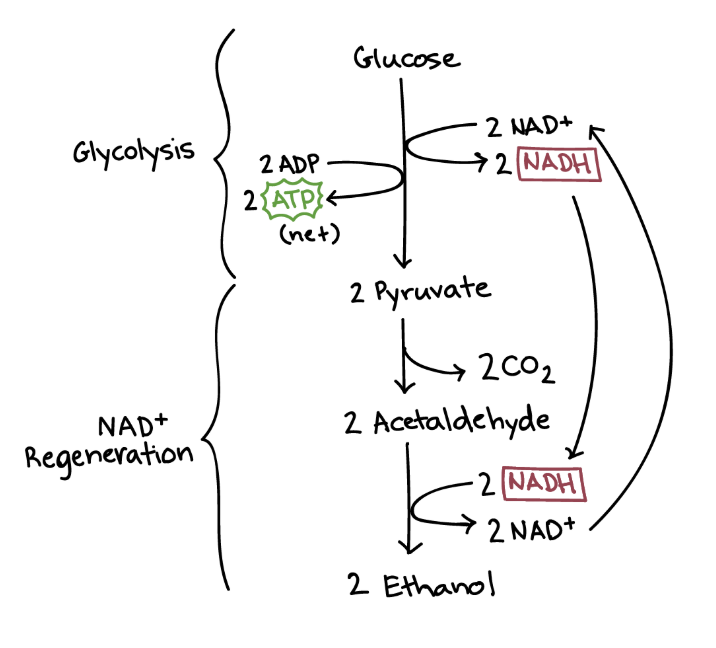Biology Khanacademy Unit 3: Cellular energetics
1/105
There's no tags or description
Looks like no tags are added yet.
Name | Mastery | Learn | Test | Matching | Spaced |
|---|
No study sessions yet.
106 Terms
Catalyst
Any solute or molecule that speeds up a reaction and makes it occur more quickly or that even allows a reaction to occur in general without itself being a reactant. These lower the activation energy needed for reactions.
They lower the activation energy by holding reactants in such a way that the bond breaking and making processes take place more readily. They allow reactants to overcome electrical repulsion more easily between each other.
The picture attached shows a comparison of the amount of activation energy needed when there is a ____ present vs when there is not.
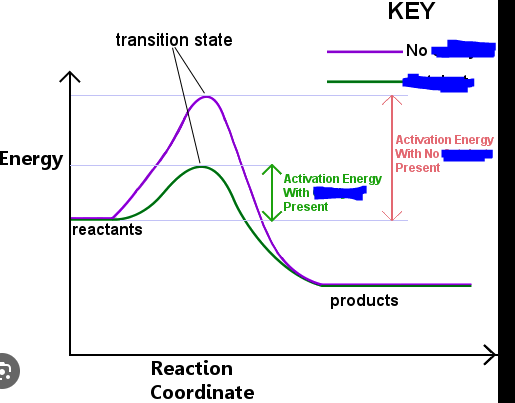
Enzymes
Biological Catalysts. They are protein complexes generally for the most part.
Tend to work well in high temperatures but if they are too high they lose their structure and thus stop having well defined active sites for substrates.
pH can also affect how efficient these things are. The optimal pH depends on the _______.
These also have multiple time uses. Active sites on ________ do not disappear after use.
_____ can catalyze reactions by providing a place for the reaction to occur. By actually bonding with substrates and facilitating the reaction or by simply bringing molecules closer. Different _____ act in different ways and speed up the reaction through various means.
These are specific to a set of or only some substrates. I.e. _____ don’t all work on the same substrates.
Image attached depicts the way in which these catalyze reactions.
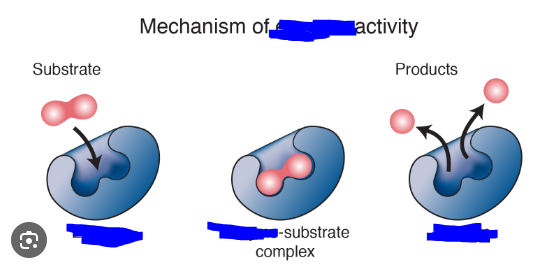
Substrates
Molecules that react and bind to the enzyme proteins in order to have their reactions facilitated. Basically the substance on which an enzyme acts.
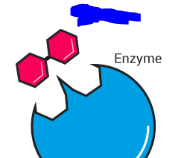
Active Site
A region on an enzyme that binds to a protein or other substance during a reaction.
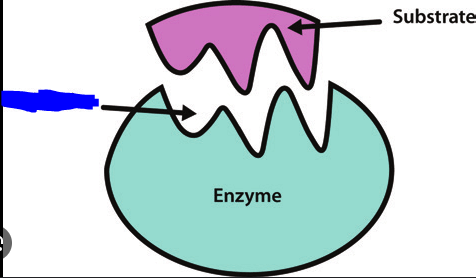
Induced Fit Model
The model that suggests substrates cause enzyme active sites to morph and bend to a certain degree when binding to them in order for the substrate to lock itself into the site and fit into it appropriately.
Not all enzymes do this, some follow the lock and key hypothesis and their shape perfectly complements the substrates which they catalyze.
Note also that it is not a dichotomy, enzymes lie on a continuum ranging from following the ________ to the Lock and Key Model. Different enzymes have varying degrees of specificity.
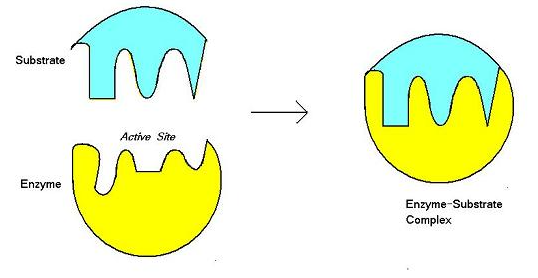
Lock and Key Model
The model that suggests substrates and enzymes are both designed in ways and shapes that perfectly complement each other and thus that allow substrates to bind to active sites on enzymes without needing to morph themselves. This is similar to how certain keys are made for certain locks.
Note that it is not a dichotomy, enzymes lie on a continuum ranging from following the Induced Fit Model to the _________. Different enzymes have varying degrees of specificity.
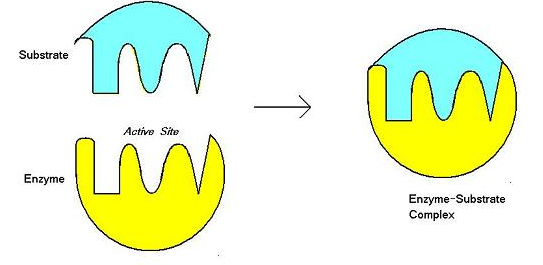
Activation Energy
The amount of energy required by a chemical reaction as initial input in order for the reaction to begin. This initial energy is usually paid back by the reaction.
The source of this energy is typically heat.
The higher the _____ the slower the rate of the reaction will be. This is because molecules only react after reaching the transitional state and having enough energy to do so.
More energy needed => Less molecules that reach this energy and the transitional state => slower reaction
Transition State
A high energy, and unstable state for a molecule to be in, that is only achieved through the addition of activation energy. This state is unstable and hence molecules do not stay in it for too long. Molecules must be contorted into this state and this state is required for bonds to be broken.
When an energy over time curve is mirrored over the vertical line at the _______ state, the product is the energy over time curve of the backward reaction.
After this state is reached the rest of the reaction proceeds.
This state, or rather the amount of energy needed to achieve it, is lowered by enzymes
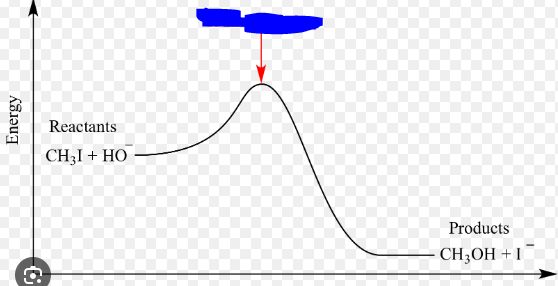
Catalysis
The process of lowering the activation energy needed for a reaction to occur and by consequence also speeding up the rate at which the reactants in the reaction react to make products.
Classic Competitive Inhibition
A molecule (Competitor) competing with a molecule of an intended substrate by binding to an active site on an enzyme and taking its place consequently preventing the intended substrate from binding.

Allosteric Competitive Inhibition
A molecule (competitor) binding to an allosteric site resulting in blockage of the active site through some means and thus preventing the enzyme from binding to a substrate.
Usually the conformation of a protein changes thus blocking the active site after a molecule binds to an allosteric site in this process.
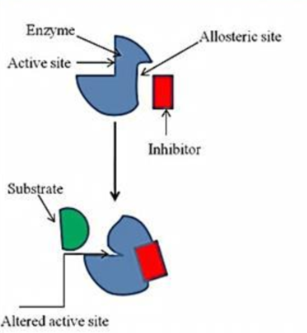
Allosteric Site
A unique region of an enzyme, other than the substrate binding site, that affects catalysis. Can affect either in a good way or bad way by allowing substrates to bind or resulting in ______ competitive inhibition.
Picture attached shows an allosteric inhibitor binding to an allosteric _____.
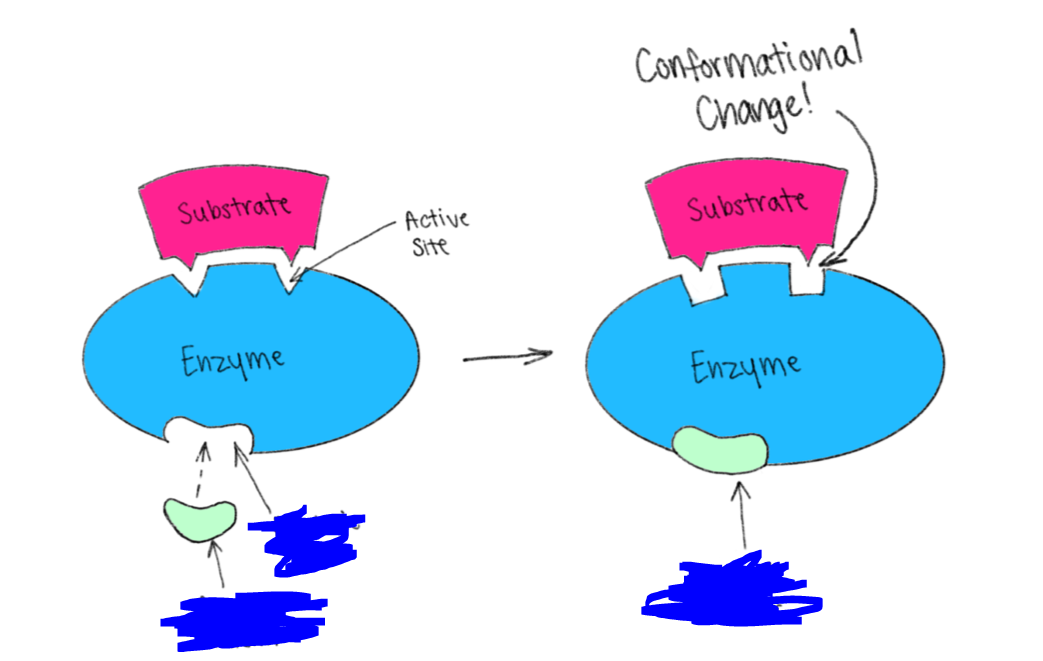
Competitive Inhibition
Inhibition of an enzyme binding to a substrate as a result of another molecule binding to the enzyme preventing catalysis either through allosteric means or classical means.
In this type of inhibition molecules compete for the active or allosteric sites on an enzyme. Only one molecule binds to the enzyme in this type of inhibition.
With this type of inhibition, given enough substrate, an enzyme can still reach its maximum reaction rate unlike in noncompetitive inhibition.
Noncompetitive Inhibition
Type of inhibition in which both substrate and inhibitors can bind to an enzyme however the reaction still does not carry on due to the inhibitor. After this occurs either both molecules or only the substrate may unbind however no matter what catalysis and the reaction will not occur.
With this type of inhibition an enzyme can never reach its maximum reaction rate, even when given an infinite amount of substrate. This is because enzymes with ________ inhibitors are “poisoned” and can not carry out reactions.
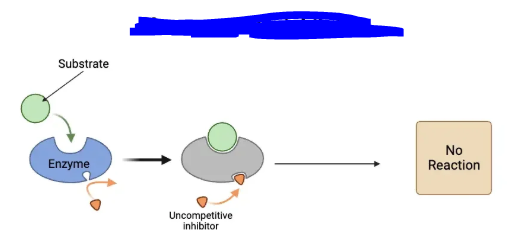
Inhibitor
A molecule that prevents/inhibits the catalysis of a substrate by an enzyme. This prevention can either be through competitive or non-competitive inhibition. Thus these can either be competitive or noncompetitive ______.
If they are noncompetitive a reaction will never reach its maximum rate.
If they are competitive a reaction will eventually reach its maximum rate, just more slowly.
The picture attached shows a competitive ______.
These decrease the activity of an enzyme.
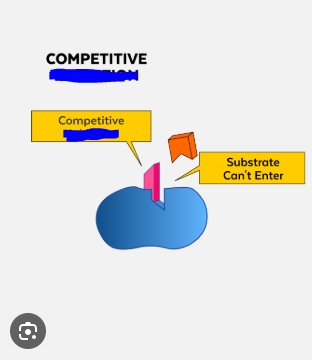
Activators
Molecules that increase the activity of an enzyme. One type are allosteric _____ which bind to an allosteric site and conform the enzyme allowing substrates to bind to the active site. These types of activators are outlined in the picture attached.
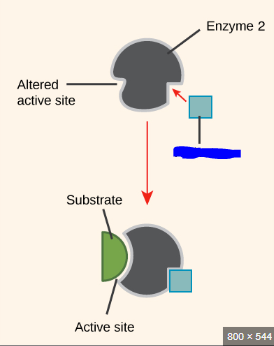
Cooperativity
In the context of enzymes, the process of a substrate serving as an allosteric activator by binding to an active site resulting in either the activity of another active site on the same enzyme going up or resulting in a conformational change in shape that opens up other active sites on the same enzymes. The picture attached shows the latter occurring.
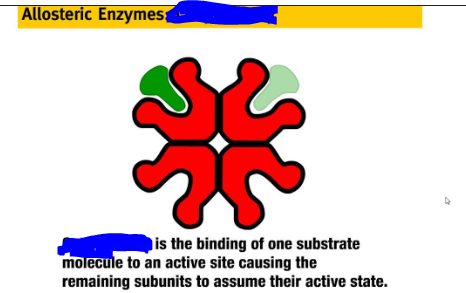
Cofactors
Protein helper molecules that allow enzymes to work optimally or to even work in general. These can temporarily be bound to enzymes through ionic or hydrogen bonds or can permanently be bound to them through covalent bonds.
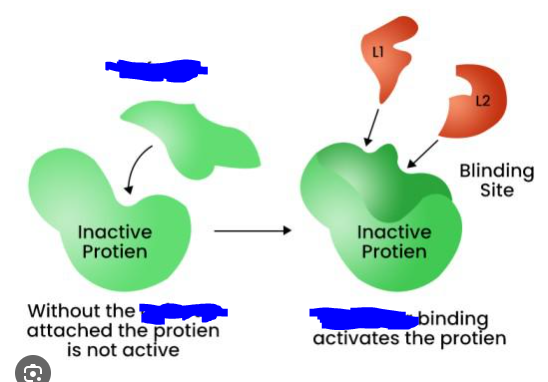
Coenzymes
A subset of cofactors that are organic, i.e. carbon based molecules. Dietary vitamins are an example of these types of cofactors, they help certain enzymes to work optimally or even allow them to function in general.
Feedback Inhibition
A type of allosteric inhibition used by enzymes to regulate the amount of a product produced. In this type of inhibition the product substrates produced by an enzymes act as allosteric inhibitors allowing enzymes to change conformational shape after producing products.
This helps regulate the amount of products in that if there are too many of them, _________ inhibition will occur resulting in a decrease in production of products, if there are too little it will not occur resulting in an increase in production.
ATP is an example of this as it is used in cellular respiration. If too much is made it inhibits cellular respiration which is good as if more ATP were to be made by cellular respiration it may go to waste due to ATP’s unstable nature to break down into ADP and other molecules.
ADP is an example of the opposite, it is an allosteric activator that activates the same enzymes inhibited by ATP. Thanks to this activation more ATP molecules are made through cellular respiration that then inhibit cellular respiration thus regulating the process.
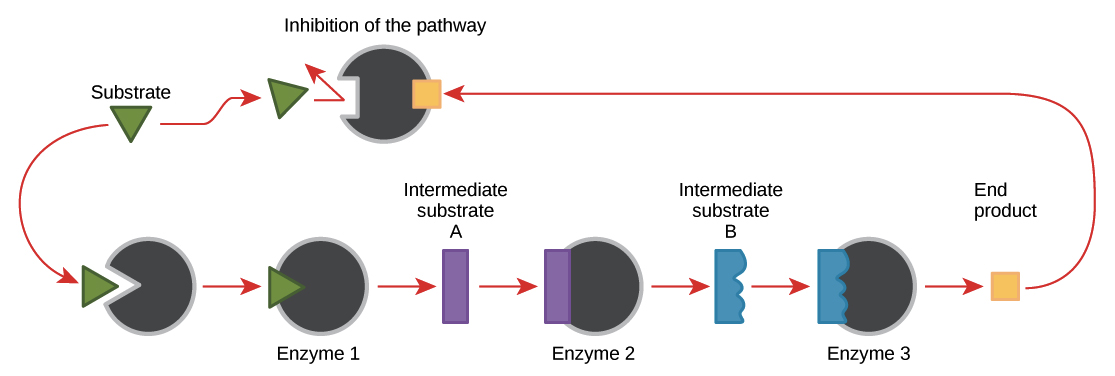
Allosteric Enzymes
Enzymes that typically have multiple active binding sites and display the property of cooperativity.
These enzymes have an S shaped graph if their rate of reaction is plotted against their concentration. This is due to their cooperativity and due to higher rate of reaction being achieved with a certain amount of substrates already there, due to the fact that substrate binding acts as an allosteric activators thus allowing for conformational change in the enzyme and allowing for more substrates to bind or on the other hand resulting in the activity of other sites going up thus resulting in a higher rate of production and higher rate of reaction in turn.
Picture attached shows an _____ enzyme.
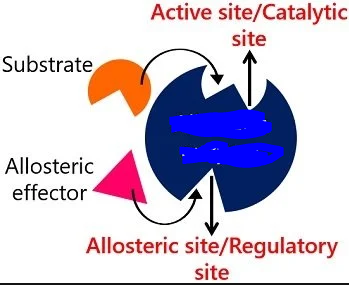
1st Law of Thermodynamics
Energy can neither be created or destroyed, only converted from one form to another.
2nd Law of Thermodynamics
Has multiple statements. One is that the entropy of the universe only inreases.
Entropy
The degree of randomness or disorder of a system, basically a measure of the “disorder” of a system. It is dependent on the natural logarithm of macrostates of the system, i.e. the number of different possible outcomes the system can have.
If a system has higher _____ it means that it is more disordered, for instance a system of a solvent with a solute that has high entropy => that the solute is diffused throughout the solvent as the solvent particles are more spread out and hence more “disordered”
The opposite is true for lower ______.
Open System
System in which both energy and mass can pass in and out and can be exchanged.
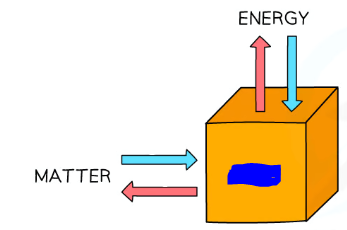
Closed System
System in which only energy can pass in and out and can be exchanged (i.e. matter can not be).
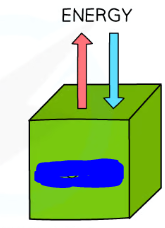
Isolated System
System in which neither energy nor mass can be exchanged.
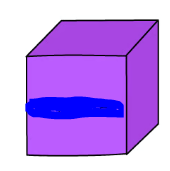
Irreversible Reactions
Reactions with such a high increase in entropy that it is unlikely for the reaction to be reversed.
An example can be a solute diffusing in a solvent. If it is initially placed in a location the entropy will increase and the solute will spread out. After it is evenly spread out although particles are still moving around it is highly improbable for all the solute particles to return back to their initial position (i.e. in one specific region). Thus this reaction is _________.
Endergonic
Reactions that absorb energy, are thermodynamically not favorable, and that can not happen spontaneously (i.e. they need other inputs to occur). These have positive gibbs free energy.
Recall that gibbs free energy = - work
since work is done on the system (as it takes in energy) work is negative and gibbs free energy must be positive.
Exergonic
Reactions that release energy, are thermodynamically favorable, and that can happen spontaneously under the right conditions such as having an enzyme and/or some activation energy (these reactions may require activation energy to start but will not need energy to continue occurring). These have negative gibbs free energy.
Recall that gibbs free energy = - work
since work is done by the system (as it releases energy) work is positive and gibbs free energy must be negative.
Reaction Coupling
The process in which two reactions are linked together, typically with one providing the energy needed for the other one to occur.
Linking often happens through a shared intermediate i.e. one product in a reaction that acts as a reactant in one of the other reactions within the _______ _______.
When this occurs the individual G values of all reactions involved are summed up and added together.
The image attached outlines an example of ______ _______.
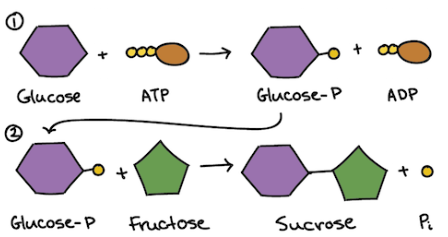
ADP - Adenosine Diphosphate
One of the products of glucose phosphorolysis. This is created during the reaction of ATP with glucose, during which ATP loses one of its phosphate groups.
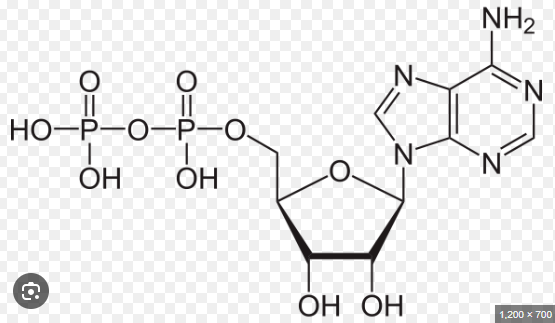
Glucose-6-Phosphate
A phosphorylated version of glucose. This version is highly important inside of cells as this version has a charge, and as a result is not able to pass through the cell membrane allowing sugar to be stored inside cells.
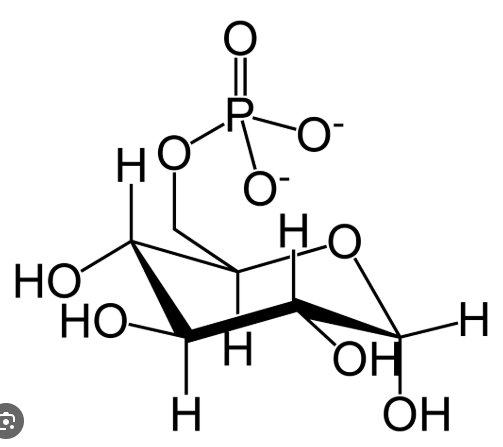
Phosphoanhydride bond
The name of the bond between two phosphate functional groups. There exist two of these within ATP and one within ADP.
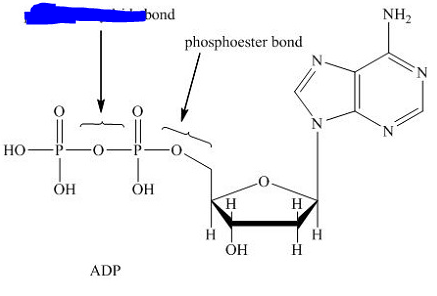
Metabolism
The set of chemical reactions that occur within living organisms to maintain life. Usually these reactions require enzymes.
Anabolism
The process of building up larger, more complex molecules from smaller ones. This process requires energy. This makes sense when considering the fact that dehydration synthesis (the process most often used to build up polymers from monomers within biological creatures) is generally an endergonic process.
This includes all the chemical reactions that do this and these, themselves, are a subset of metabolism.
Basically the complement of the set of catabolism.
Catabolism
The process of breaking down larger molecules into smaller ones. This process releases energy that can be used by an organism. This makes sense when considering the fact that hydrolysis (the process most often used to break down polymers within biological creatures) is generally an exergonic process.
This includes all the chemical reactions that do this and these, themselves, are a subset of metabolism.
Basically the complement of the set of anabolism.
Metabolic Pathway
A series of connected chemical reactions that feed one another.
Anabolic Pathway
A series of connected chemical reactions that feed one another and that contribute to the building up of a molecule larger than the initial reactants.
These are typically endergonic.
Catabolic Pathway
A series of connected chemical reactions that feed one another and that contribute to the breaking down of the initial reactants into smaller products.
These are typically exergonic.
Oxygenic Photosynthesis
The process in which light energy is converted to chemical energy in the form of sugars. The process that plants or any cells with chloroplasts use to turn sunlight into energy. The general reaction formula follows
6CO2+6H2O+48photons → C6H12O6 + 6O2
however the actual process is broken down into multiple reactions. These are just the beginning and end stages.
In this type of _______. Water molecules are split to provide a source of electrons.

Light reactions (Light dependent reactions)
Reactions within the photosynthesis process that require light in order to occur. These occur when the sun is out and require photons from the sun unlike dark reactions. Photons are absorbed by chlorophyll on the outside of thylakoids which are located inside of chloroplasts most often within mesophyll cells.
These produce ATP and NADPH.
These take place in the chlorophyll. I.e. on the phospholipid bilayer of thylakoids.
Follows the form
light + H2O → ATP + NADPH + O2
This stage is completed once ATP and NADPH accumulates in the stroma.
Calvin Cycle/Dark reactions (Light independent reactions)
Reactions within the photosynthesis process that do not require light in order to occur. These occur when the sun is out because they require the byproducts of light reactions (which need light to occur), but do not, themselves, require photons in order to occur.
These utilize NADPH and ATP from light reactions in order to produce PGAL/G3P (Phosphoglyceraldehyde/Glyceraldehyde-3-Phosphate) which can then be used to produce glucose.
These take place in the stroma i.e. in the fluid surrounding thylakoids.
Follows the form
18ATP + 12NADPH + 6CO2 → Sugar
To summarize the full extent of the cycle however
3 CO2 molecules combine with 3 RuBP in order to make 6 G3P
1 G3P exits cycle and is used for making glucose
5 G3P remaining are recycled and regenerate 3 RuBP acceptor molecules
During these processes 9 ATP are converted to ADP, 6 during the reduction and 3 during regeneration.
6 NADPH are converted to NADP+ during reduction.
Since 1 G3P contains 3 carbons and glucose contains 6 it takes 2 turns of the cycle to make glucose as 2 rotations of the cycle make 2 G3P molecules.
So every 2 Calvin cycles, 1 glucose molecule is made.
Which means 6 CO2, 12NADPH and 18 ATP molecules are required for 1 glucose molecule.
Carbon Fixation
The process of incorporating inorganic carbon into organic molecules.
This is the first stage of the Calvin cycle.
More explicitly it is the stage in which a CO2 molecule combines with ribose-1,5-biphosphate (RuBP), a five carbon acceptor molecule. This step makes a 6 carbon compound that splits into 2 molecules of a 3 carbon compound, 3-phosphoglyceric acid (3-PGA). This reaction is catalyzed by rubisco, an enzyme.
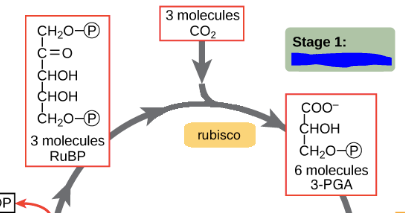
Photoautotrophs
Organisms that produce their own food, i.e. fix their own carbon, through the use of light energy.
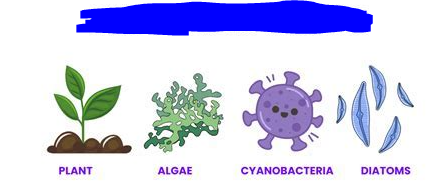
Heterotrophs
Organisms that can not convert CO2 to organic compounds on their own. These get their food by eating other organisms or their byproducts.
Humans are an example of these.

Mesophyll
The cells in a middle layer of leaf tissue. These are the primary sites of photosynthesis. These contain many chloroplasts (which follows due to their role in photosynthesis).
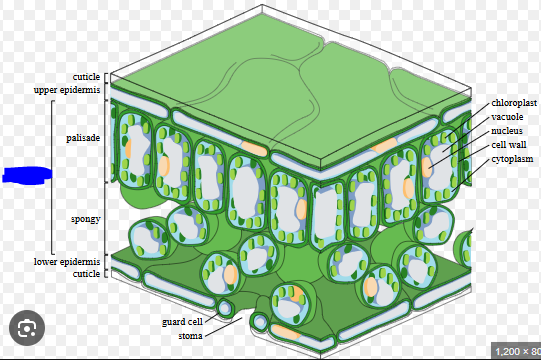
Stomata
Found on the surface of leaves in most plants. These let CO2 and O2 diffuse into and out of the mesophyll layer respectively.
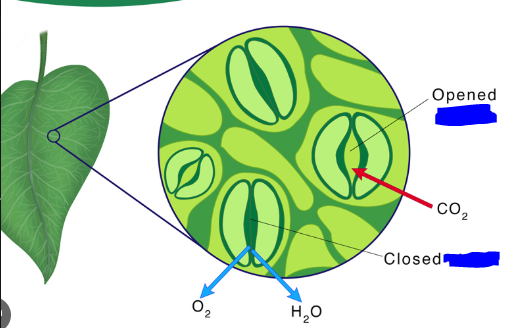
Chloroplasts
Specialized organelles that carry out photosynthesis in plant cells.
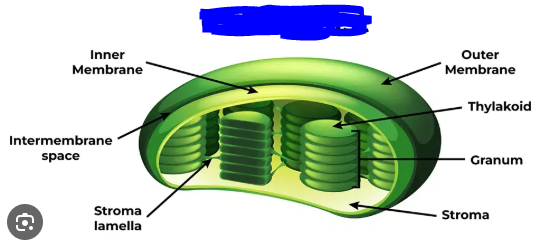
Thylakoids
Disc like structures arranged in piles/stacks that are known as grana. These are found inside of chloroplasts.
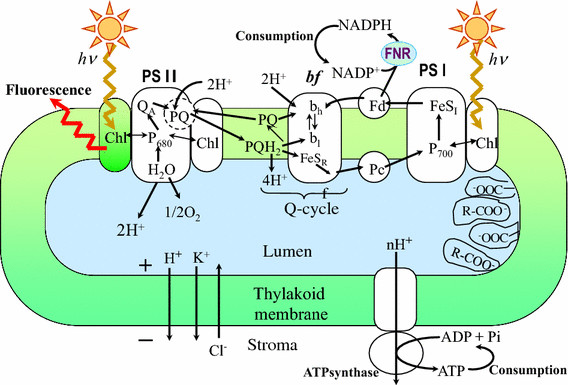
Grana
Stacks of thylakoids that are found inside of chloroplasts.

Chlorophyll
Green colored pigments that absorbed light present on the membrane of thylakoid organelles. On a molecular level these are amphipathic and have their hydrophilic end bonded to the hydrophilic outside of the thylakoids phospholipid bilayer and their hydrophobic end bonded to the inside of the thylakoids phospholipid bilayer.
The picture attached shows 2 different forms of _______ on a molecular level. ______ a is responsible for both P680 and P700 special pairs. These are composed of 2 ______ molecules as the name suggests.
P680 (named due to absorbing optimal light of wavelength 680nm) is involved in photosynthesis and light dependent reactions. It has electrons which become excited through absorption of photons and make their way down molecules. As this occurs H+ cations are able to move into the stroma within a thylakoid.
This creates a concentration gradient with lower concentration outside the cell and through ATP synthase, H+ cations move to the outside of the cell and as a consequence ATP is produced from ADP and a phosphate group.
P700 (named due to absorbing optimal light of wavelength 700 nm) is involved also in light dependent reactions and photosynthesis. It reduces NADP+ into NADPH after which it absorbs 2 electrons from P680 that are travelling down molecules in order to reduce itself back into P700 from P700+. To neutralize NADP+ into NADPH it carries out the process of releasing 2 electrons that reduce NADP+ in order to give NADP+ 2 electrons that it can then use to grab a hydrogen cation within the stroma.
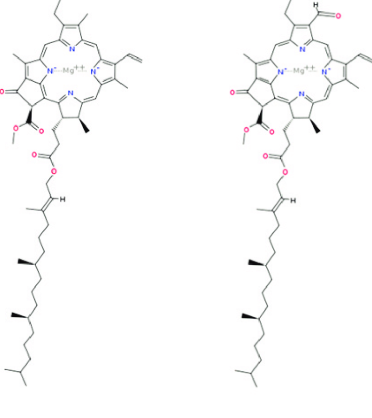
Stroma
Fluid filled space surrounding the grana within a chloroplast organelle.
Not to be confused with stomata which are found on the surface of leaves in plants and are used to let in CO2 and release O2.

Thylakoid Space
The space inside of thylakoid discs, which themselves, are located within chloroplasts.
Nicotinamide adenine dinucleotide phosphate - NADPH
A molecule produced as a result of light reactions during photosynthesis and which is also used by the Calvin cycle.
This is a reducing agent as it is able to donate electrons to oxidize another material and thus become positively charged. In doing this it becomes NADP+ losing its H+ cation and 2 electrons thus having an overall +1 positive charge.
This molecule is created during light dependent reactions through the reduction of NADP+
This molecule donates its electrons during the Calvin cycle in order to convert CO2 into sugars.
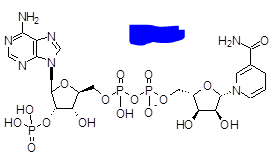
Adenosine Triphosphate
The main unit of energy within cells. This molecule is an energy storage molecule. It is a product of light reactions during photosynthesis.
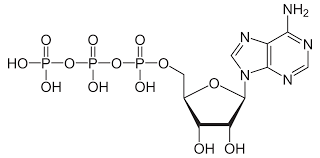
Glyceraldehyde-3-phosphate
A molecule produced as a result of the Calvin cycle. This molecule later joins up with 2 of the same molecules in order to form glucose near the ending of the process of photosynthesis.
It is, specifically, a 3 carbon sugar created using 3-PGA molecules in the reduction stage of the Calvin cycle (i.e. the second stage). This molecule is also recycled in order to regenerate RuBP acceptor molecules during the regeneration stage (i.e. last stage) of the Calvin cycle.
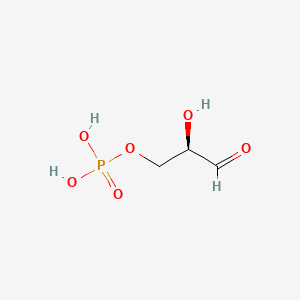
ATP-Synthase
An enzyme, molecular motor, and ion channel all wrapped together in one structure. Used in cycles to produce ATP and to move H+ cations across layers.
One example of this enzyme being used is within thylakoids in order to produce ATP and move H+ ions across their concentration gradient. It produces ATP by binding a phosphate group to ADP.
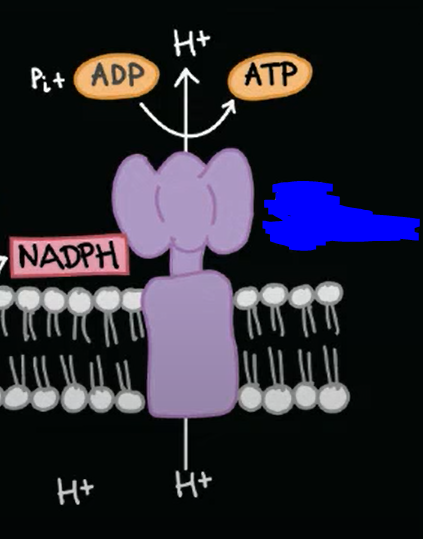
Photosystem 2/PS2
The process of P680 absorbing photons and having excited electrons. These electrons then travel into the thylakoid lumen and by doing so attracts H+ cations to also travel inside the thylakoid lumen. As a result an H+ concentration gradient is made with lower concentration outside the organelle.
After this P680 becomes an oxidising agent turning into P680+ and becomes powerful enough to break apart water. It does this within the thylakoid lumen breaking apart H2O usually in pairs of 2 into 4H+ + 2O + 4e-. The 4H+ contribute to the concentration gradient, 4e- are stored with 2 being used to neutralize P680+ and O will be paired with the other O to form O2.
Lastly ATP is created when H+ ions move across the ATP-synthase. In order to move H+ ions from the thylakoid lumen into the stroma; the ATP-synthase binds ADP to a phosphate group creating ATP.
_____ can be attributed to P680.
This system replenishes electrons and reduces their chlorophyll special pairs by oxidizing water and stealing electrons.
P680 molecules are transmembrane integral proteins.
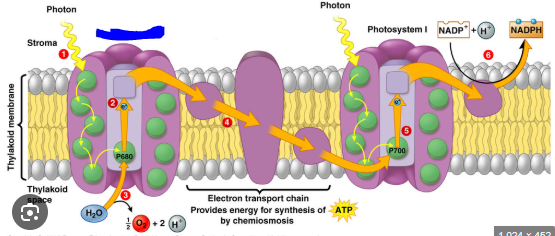
Photosystem 1/PS1
The process of P700 gaining excited electrons that then contribute to reducing NADP+ into NADPH. After P700 loses 2 electrons and becomes P700+ it absorbs 2 electron going across molecules into lower energy states, this being the same electrons created during the running of photosystem 2.
_____ can be attributed to P700.
This system replenishes electrons by taking the ones flowing down from PS2 along an electron transport chain.
P700 molecules are transmembrane integral proteins.
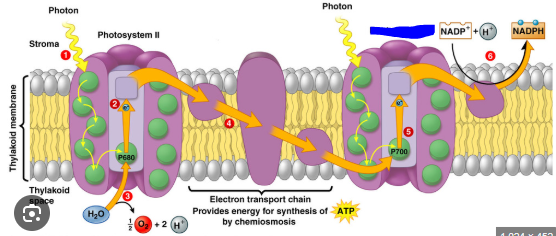
non-cyclic photophosphorylation/linear photophosphorylation
The standard and usual, however not the only, process that occurs during light dependent reactions. During this process photons excite 2 electrons located on a P680 molecule. These electrons then escape and travel across molecules down into the thylakoid lumen. The now P680+ molecule then oxidizes 2 water molecules (assuming there are no available electrons left) and splits it into 4H+ 4e- and 2O stealing 4 of the electrons and using 2 to reduce itself back to P680, forming 4H+ cations which contribute to the concentration gradient of H+ cations inside the thylakoid lumen, and forming oxygen using the 2O.
As the electrons originally released travel downwards, H+ cations are attracted inside the thylakoid lumen by them and these themselves contribute to the concentration gradient. In reality the electrons lose energy and the energy lost is used to drive the movement of H+ cations into the thylakoid lumen.
Simultaneously as this occurs a P700 molecule reduces NADP+ into NADPH by carrying out the process of releasing another 2 electrons excited by photons down an electron transport chain and becoming P700+. Afterwards which it, itself, becomes reduced, by the electrons travelling down molecules initially released by the P680 molecule which arrive through an electron transport chain, thus turning P700+ back into a P700 chlorophyll molecule. This creates NADPH through NADP+ reduction and it is released outside the cell, i.e. inside the stroma.
Lastly due to the H+ concentration gradient formed, the ATP synthase carries H+ cations outside into the stroma as well however in order to do so it must bind ADP with another phosphate group, thereby creating ATP and generating energy while also carrying H+ cations across the concentration gradient. Note that the ATP-synthase is not a carrier or channel protein but rather a protein complex.
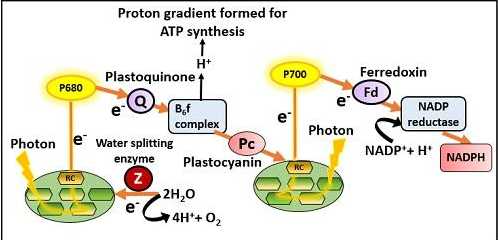
Special Pair
The reaction center of a photosystem that contains a unique pair of chlorophyll a molecules. These molecules can actually lose an electron when excited.
These are responsible for the release of electrons when any other chlorophyll molecules/pigment become excited. Once energy is passed to these through direct EM transfer they lose electrons. These are involved in both photosystems 1 and 2.
Two examples of ____ ____ are p680 and p700 which are composed of 2 chlorophyll a molecules and are responsible for processes in PS2 and PS1 respectively.
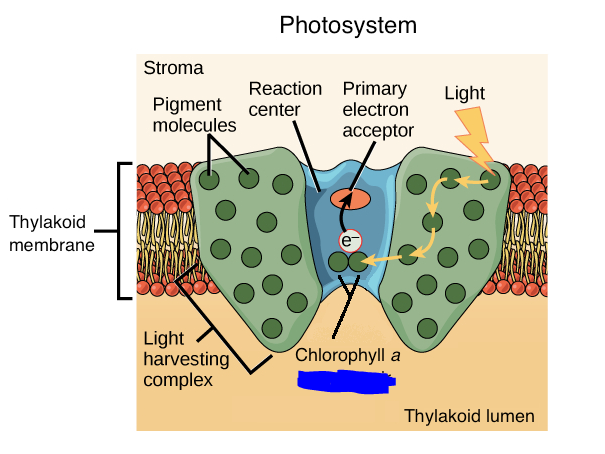
Pheophytin
An organic molecule that resembles chlorophyll and which is also the primary electron acceptor within PS2. Its job is to transport excited electrons released by the P680 chlorophyll special pairs and aids in transporting them to the p700 chlorophyll special pairs.
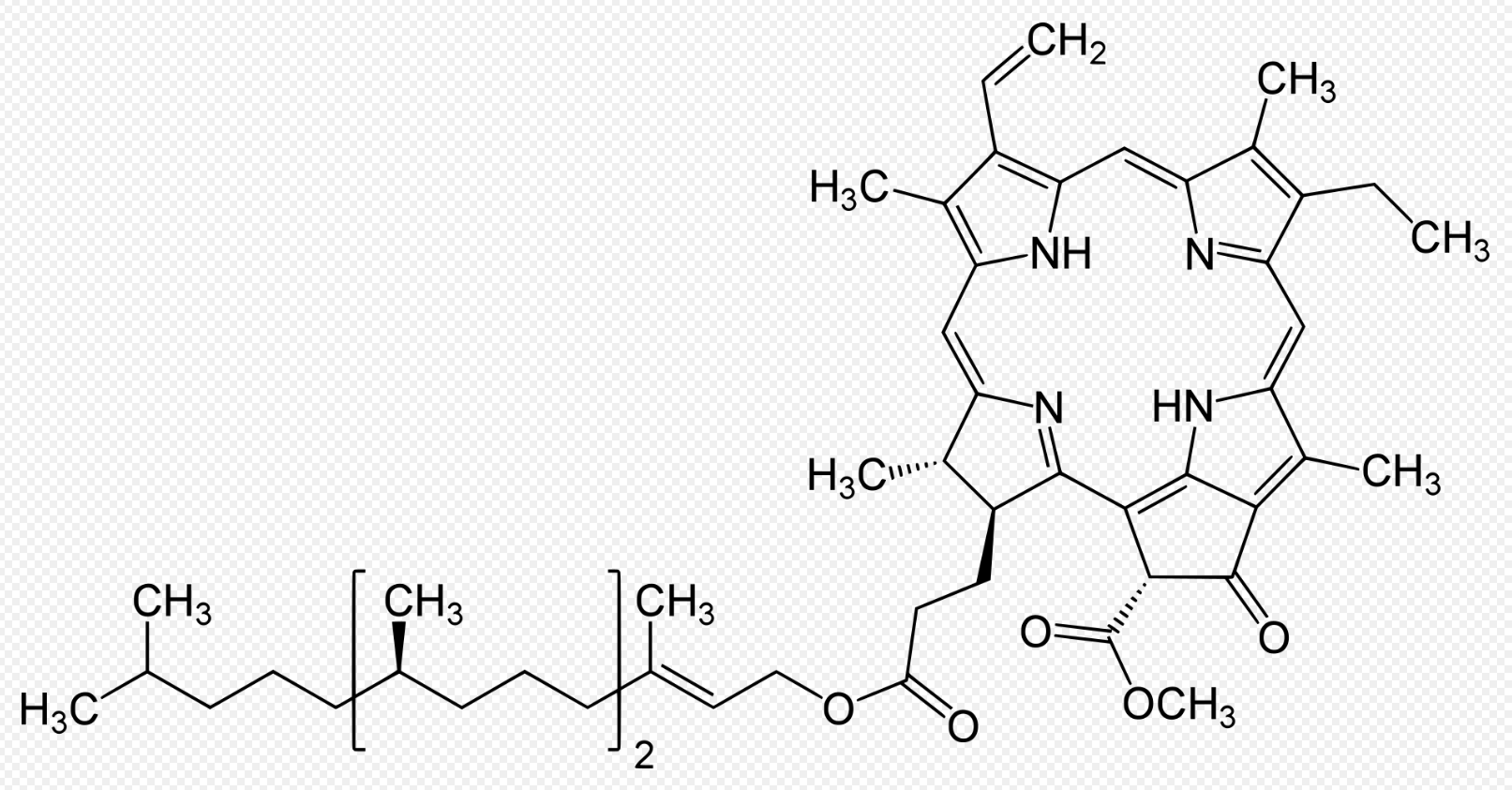
Chlorophyll A₀
The primary electron acceptor within PS1. Its job is to transport excited electrons released by the P700 chlorophyll special pairs and aid in transporting them to the NADP+ molecule that is reduced.
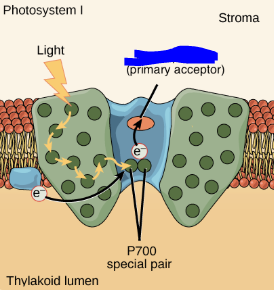
Cyclic photophosphorylation
Electrons looping back through PS1 rather than ending up in NADPH and contributing to the reduction of NADP+. In this process the electrons repeatedly go back to an earlier stage of the electron chain going down to PS1 (however not as early as going back to PS2) and as a result continue to drive proton pumping inside the thylakoid lumen.
This usually occurs when the ratio of NADPH to NADP+ is too high and there is too much NADPH such that making more would be a waste and it would be more beneficial to wait until the existing molecules are used up by the Calvin cycle.
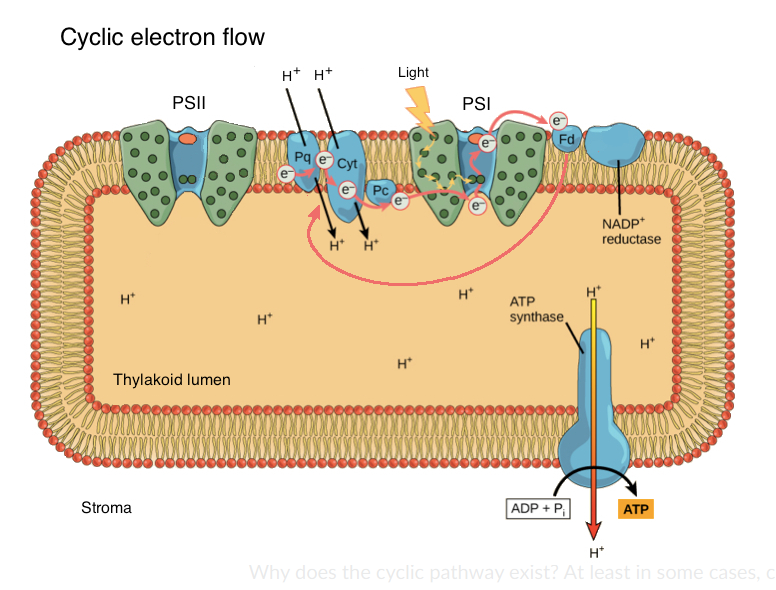
Ribulose-1,5-biphosphate (RuBP)
A molecule that is involved in the first part of the Calvin cycle and that is regenerated in the third. This molecule acts as an acceptor molecule and contains 5 carbons.
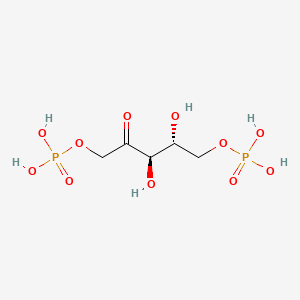
3-phosphoglyceric acid (3-PGA)
The final product of the reactions carried out within the first stage of the Calvin cycle, i.e. during carbon fixation. This is a three carbon molecule.
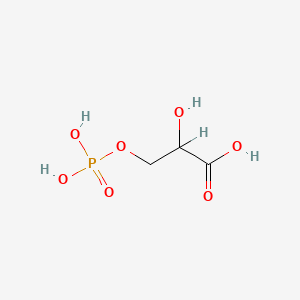
Rubisco
An enzyme involved in the first stage of the Calvin cycle, i.e. during carbon fixation. This enzyme is tasked with catalyzing the reaction that produces 3-phosphoglyceric acid by breaking up a 6 carbon molecule that is the product of CO2 and ribulose-1.5-biphosphate into 2, 3 carbon molecules.
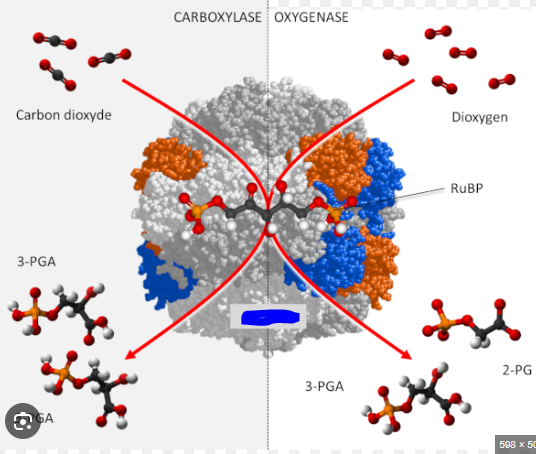
Reduction
The second stage of the Calvin cycle. ATP and NADPH are used to convert 3-PGA molecules into molecules of a 3 carbon sugar, glyceraldehyde-3-phosphate. NADPH reduces a 3 carbon intermediate to make a G3P in this stage hence the name of the stage.
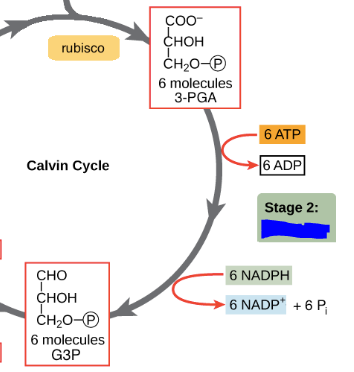
Regeneration
The stage in which some G3P molecules go to make glucose while others are recycled to generate the RuBP acceptor molecules. ________ requires ATP and involves a complex network of reactions.
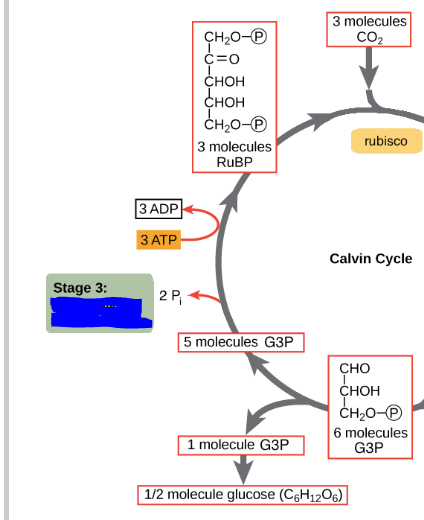
Cellular Respiration
The process by which cells derive energy from glucose. This is approximately the reverse reaction of photosynthesis.
The formula for this is C6H12O6 + 6O2 → 6CO2 + 6H2O + energy (heat energy and 38 ATPs)
Number of ATP molecules created as a result of this is not always constant. Depending on the cell it may vary.
Occurs in cytoplasm and mitochondria matrix.
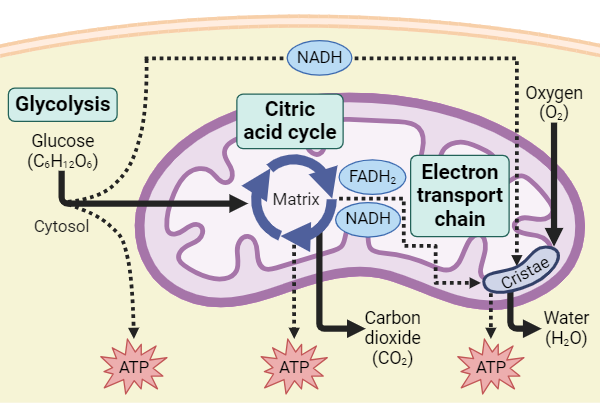
Glycolysis
The metabolic pathway that breaks up glucose into pyruvate thus releasing energy in the process (ATP and converting NAD+ to NADH).
During this process a glucose molecule is broken up into 2 pyruvate molecules and 2 ATP molecules are needed but 4 are generated. Additionally 2 NAD+ are converted to NADH
This cycle is anaerobic i.e. it does not require oxygen around.
This is the first stage in cellular respiration.
This is a sequence of 10 reactions.
Occurs in the cytosol.
This reaction can be summed up to
Glucose + 2ADP + 2NAD+ +2P_i → 2 Pyruvate + 2 NADH + 2H2O
The picture attached outlines ______ during cellular respiration.
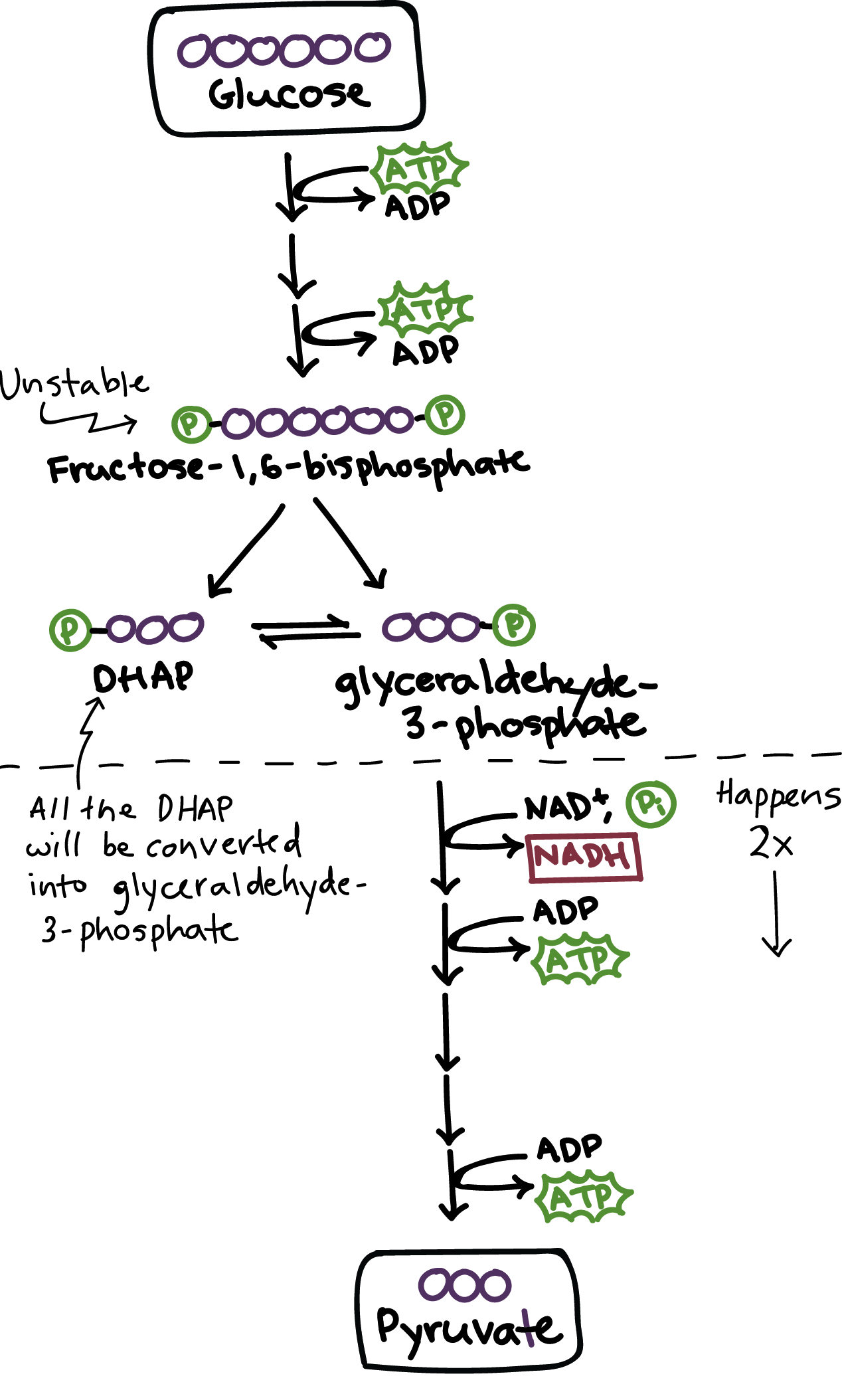
Krebs Cycle/Citric Acid Cycle
A cycle within which pyruvate product molecules from glycolysis enter after they have been re-engineered into Acetyl-CoA. This cycle generates 2 ATPs
This cycle is aerobic i.e. it requires oxygen around. It does not directly require oxygen however it requires Oxidative Phosphorylation to occur which requires oxygen.
This is the third stage in cellular respiration assuming there is oxygen.
Occurs in the mitochondria matrix (for eukaryotes).
The reactions in this cycle can be summed up to
2 Acetyl-CoA → 6 NADH + 2 FADH2 + 2 ATP (Note that one glucose turns into 2 pyruvate which turn into 2 Acetyl-CoA so for each glucose 2 ____ cycles).
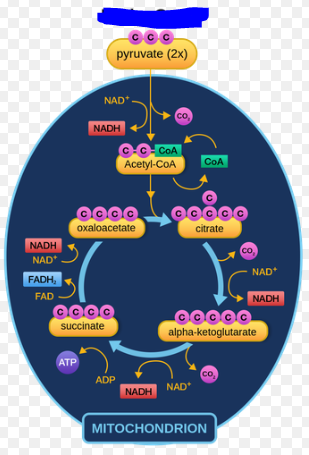
Electron Transport Chain
A chain that transports electrons.
In cellular respiration this produces the bulk of ATP, usually 34 molecules. This cycle i.e. the one during cellular respiration, is aerobic i.e. it requires oxygen around.
PS2 and PS1 are also examples of ___ ____ ____.
The picture attached outlines an ____ ____ ____ used during cellular respiration.
Occurs on cristae on membranes in regards to the Krebs cycle.
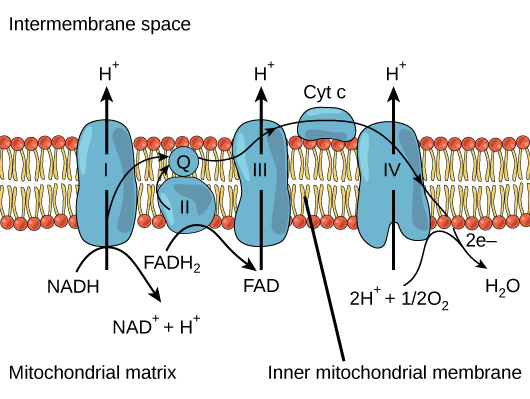
Fermentation
An anaerobic path way for breaking down glucose. In this pathway only glycolysis occurs with 1 or 2 extra reactions at the end.
The side process through which glycolysis byproducts go through when there is not enough oxygen around to carry out aerobic cellular respiration.
This process is anaerobic.
Humans do lactic acid _____. Some organisms do alcohol ______.
This pathway does not require a mitochondria or nucleus unlike aerobic respiration which does.
The picture attached shows _________ in humans.
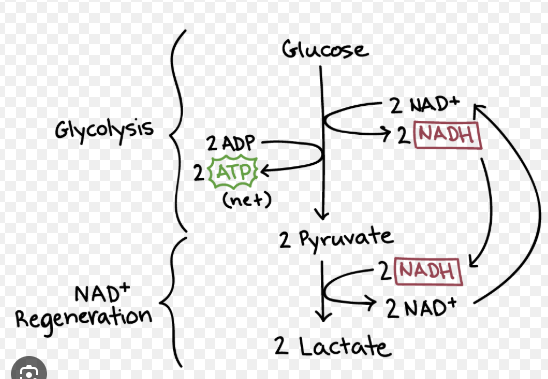
Nicotinamide adenine dinucleotide (NAD) + hydrogen (H)
A molecule that is a byproduct of glycolysis and produced in the Krebs cycle. Specifically 10 molecules are produced.
This is the reduction of NAD+.
These molecules drive the electron transport chain in the third stage of aerobic cellular respiration.
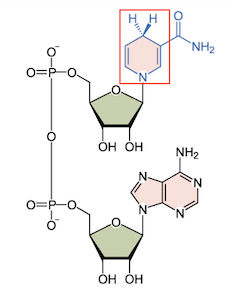
Substrate-Level Phosphorylation
A metabolic process by which ATP (or GTP) is produced by transferring a phosphate group directly from a high energy substrate molecule down to an ADP (or GDP) molecule.
This process happens in the breaking down of glucose molecules during cellular respiration specifically during the first stage, glycolysis.
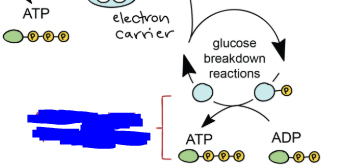
Oxidative Phosphorylation
The phosphorylation of ADP to ATP (or GDP to GTP) through the use of free energy produced from redox reactions in an electron transport chain. This process occurs within photosynthesis and within the Krebs cycle. This is specifically referring to the process of the ADP bonding to the other phosphate group in the presence of oxygen.
Within the Krebs cycle this process is the last step. During this NADH and FADH2 transport their electrons in an electron transport chain and turn back into NAD+ and FAD. As electrons move down the transport chain H+ ions are pumped into the inter membrane space of the mitochondria forming a gradient.
Due to the concentration gradient formed, H+ cations flow back into the matrix through the ATP synthase enzyme which forms ATP.
At the end of the electron transport chain oxygen hogs the electrons transferred and takes H+ cations (that have travelled inside the matrix) in order to form water.
Note that all NADH and FADH2 molecules made during the whole cellular respiration cycle now donate their electrons in order to create ATP
This process is the combination of the electron transport chain and chemiosmosis.
This process can be summed up by
10 NADPH + 2 FADH2 → 26-28 ATP (depending on the yield from 2 NADH created during glycolysis which can vary by 3-5 ATP)
This stage directly needs oxygen to occur as water is made using oxygen atoms through the reaction
2H2 + O2 → 2H2O.
The picture attached outlines _____ _____ during cellular respiration.
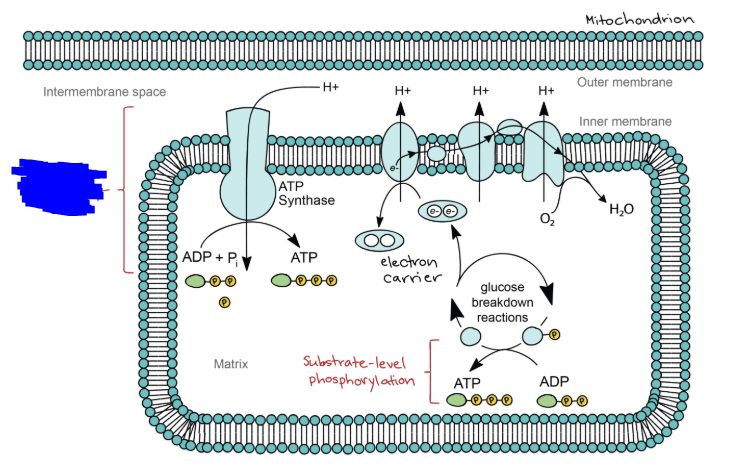
Redox Reactions/Oxidation-Reduction Reactions
Reactions involving electron transfers. If a molecule gains electrons we say it is reduced. If a molecule loses electrons we say it is oxidized.
Even if bonds are made ____ reactions can still happen due to some parts of a molecule being more electronegative and hogging more electrons and thus being reduced.
For instance 2H2 + O2 → 2H2O is an example of a ____ ____ because the oxygen atoms are more electronegative and will hog the electrons generally more. (recall h2o is polar).
As a general rule of thumb for organic molecules. If an H atom is gained or an O is lost the molecule becomes reduced.
Inversely if an H atom is lost or O is gained the molecule becomes oxidized.
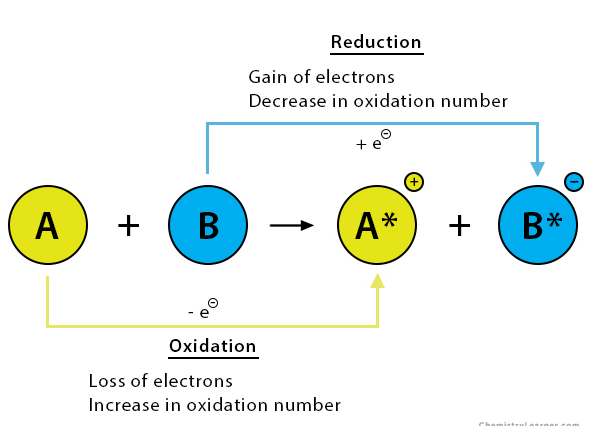
Pyruvate
A molecule generated during glycolysis. Glycolysis usually generates 2 _____ molecules as outlined during the first stage of cellular respiration.

Flavin adenine dinucleotide + 2 Hydrogen - FADH2
A molecule composed after one cycle of the Krebs cycle.
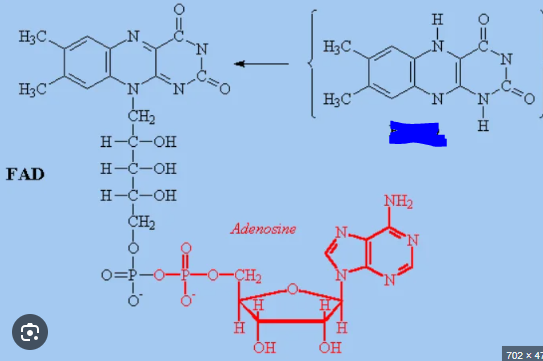
Pyruvate Oxidation
The process of each pyruvate molecule made from glycolysis travelling into the mitochondrial matrix (using ion channels because the molecule is charged) and being converted into acetyl CoA and generating NADH as well as CO2 in the process.
This is the second stage of cellular respiration
In this reaction
2 pyruvate molecules → 2 NADH + 2CO2 + 2Acetyl-CoA
In prokaryotes this occurs in the cytoplasm.
This stage is aerobic i.e. it requires oxygen however not directly. This stage requires Oxidative Phosphorylation to occur which itself requires oxygen, hence its oxidation dependency and its aerobicity.
The picture attached outlines _____ _____ during cellular respiration.
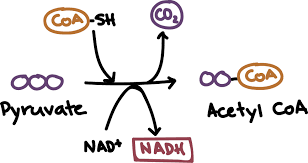
Acetyl-CoA
A molecule created as a result of pyruvate oxidation, the second stage of cellular respiration. This molecule is also used to fuel the Krebs cycle.
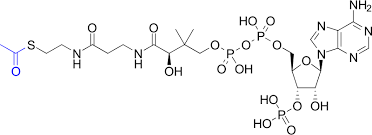
Oxaloacetate
A four carbon acceptor molecule that Acetyl-CoA combines with at the start of the Krebs cycle. This molecule is regenerated near the end.
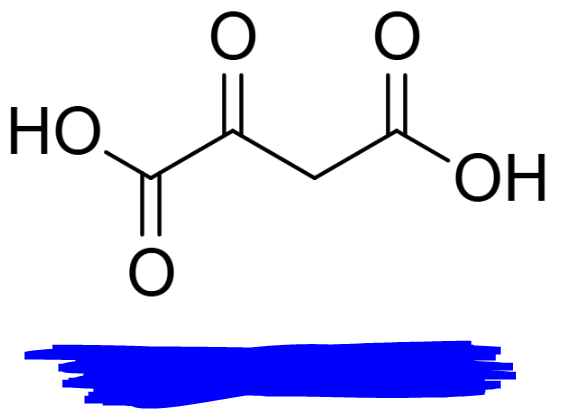
Citrate
A six carbon molecule formed by the combination of Acetyl-CoA and oxaloacetate during the beginning of the Krebs cycle.
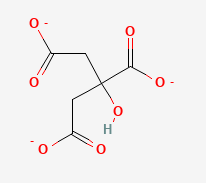
Electron Transport Chain
A series of proteins and organic molecules found in the inner membrane of the mitochondria. Electrons are transported through them through various redox reactions.
The chain of enzymes/proteins, within a plasma membrane, that are responsible for transporting electrons along a plasma membrane and for producing energy while doing so (through pumping H+ cations and creating a gradient. ATP is then produced through ATP synthase and H+ cations coming back inside)
Oxygen sits at the end of this chain within the Krebs cycle with the purpose of being reduced by electrons.
Found in the plasma membrane in prokaryotes and in the inner mitochondrial membrane in eukaryotes.
Has complexes labeled 1-4
The picture attached outlines an example of an _____ ____ ____
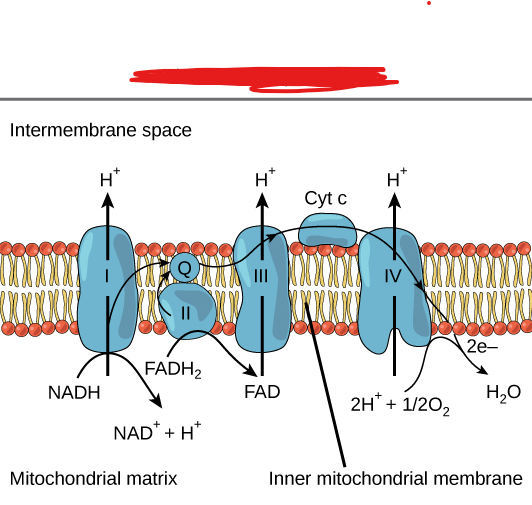
Proton-Motive Force
The electrochemical gradient formed by the pumping of H+ cations into a region. This pumping is facilitated by the energy from an electron that goes through the electron transport chain. Specifically the force this gradient creates.
One example of when this force occurs is during oxidative phosphorylation.
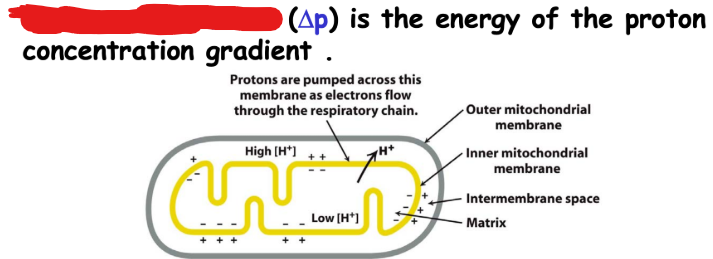
Chemiosmosis
The process in which energy from a proton gradient is used to make ATP. More broadly the process of having energy stored in a gradient used to do work.
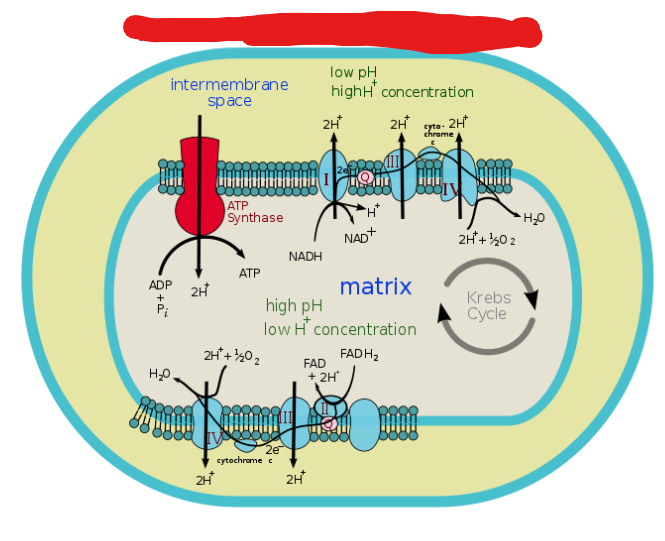
Complex 1: NADH Dehydrogenase
Part of the electron transport chain.
Made up of polypeptides with a flavin mononucleotide molecule (FMN) also called a flavoprotein and an Fe-S protein with iron and sulfur bound to it which transfers electrons to ubiquinone, a small mobile carrier. This complex does not accept deposited electrons from FADH2 as FADH2 is a worse donator of electrons.
This complex pumps protons into the intermembrane space.
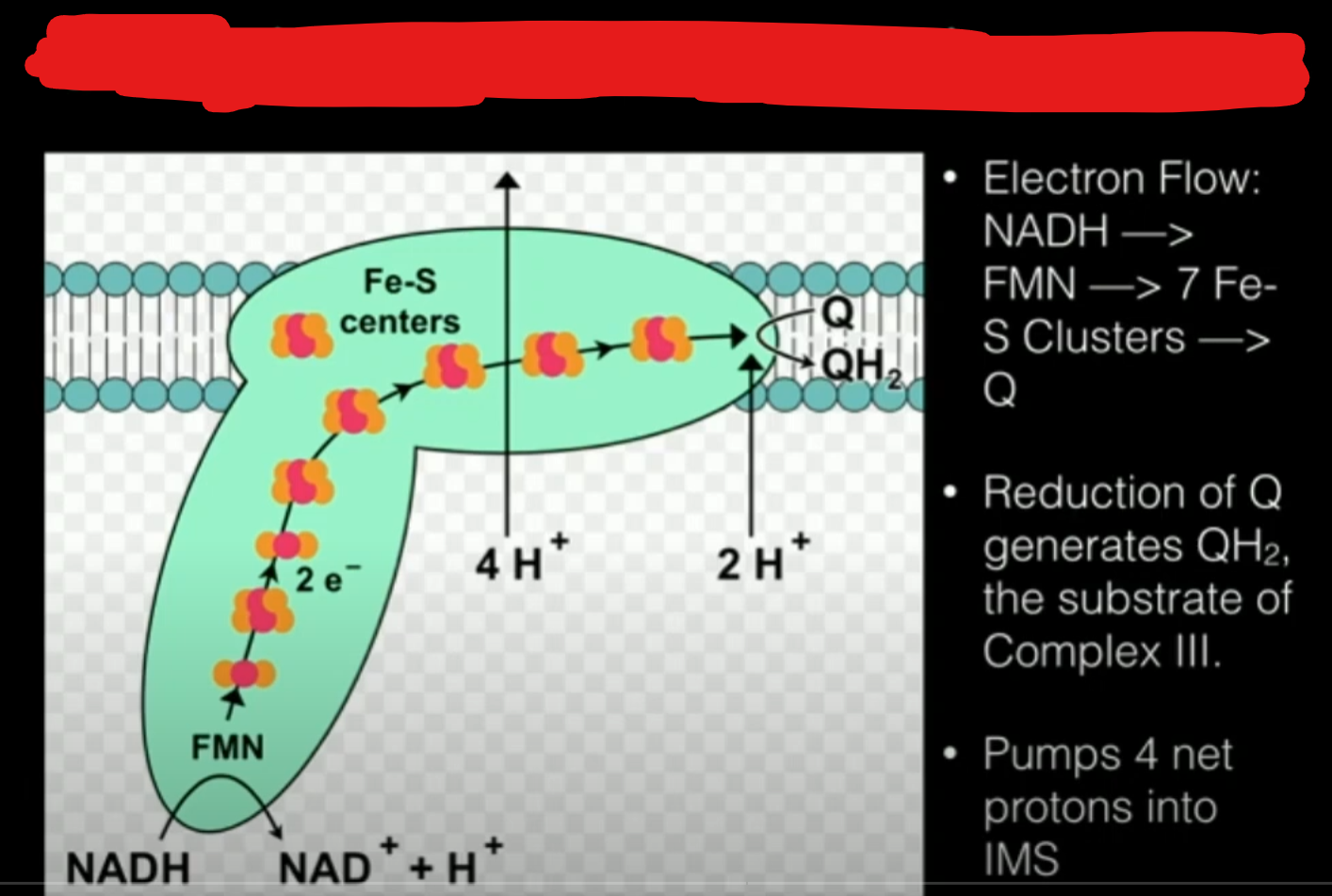
Complex 2: Succinate Dehydrogenase
Part of the electron transport chain
Contains iron sulfur proteins that accept FADH2 electrons and which pass them to ubiquinone, the same mobile carrier from complex 1.
Pumps protons into intermembrane space
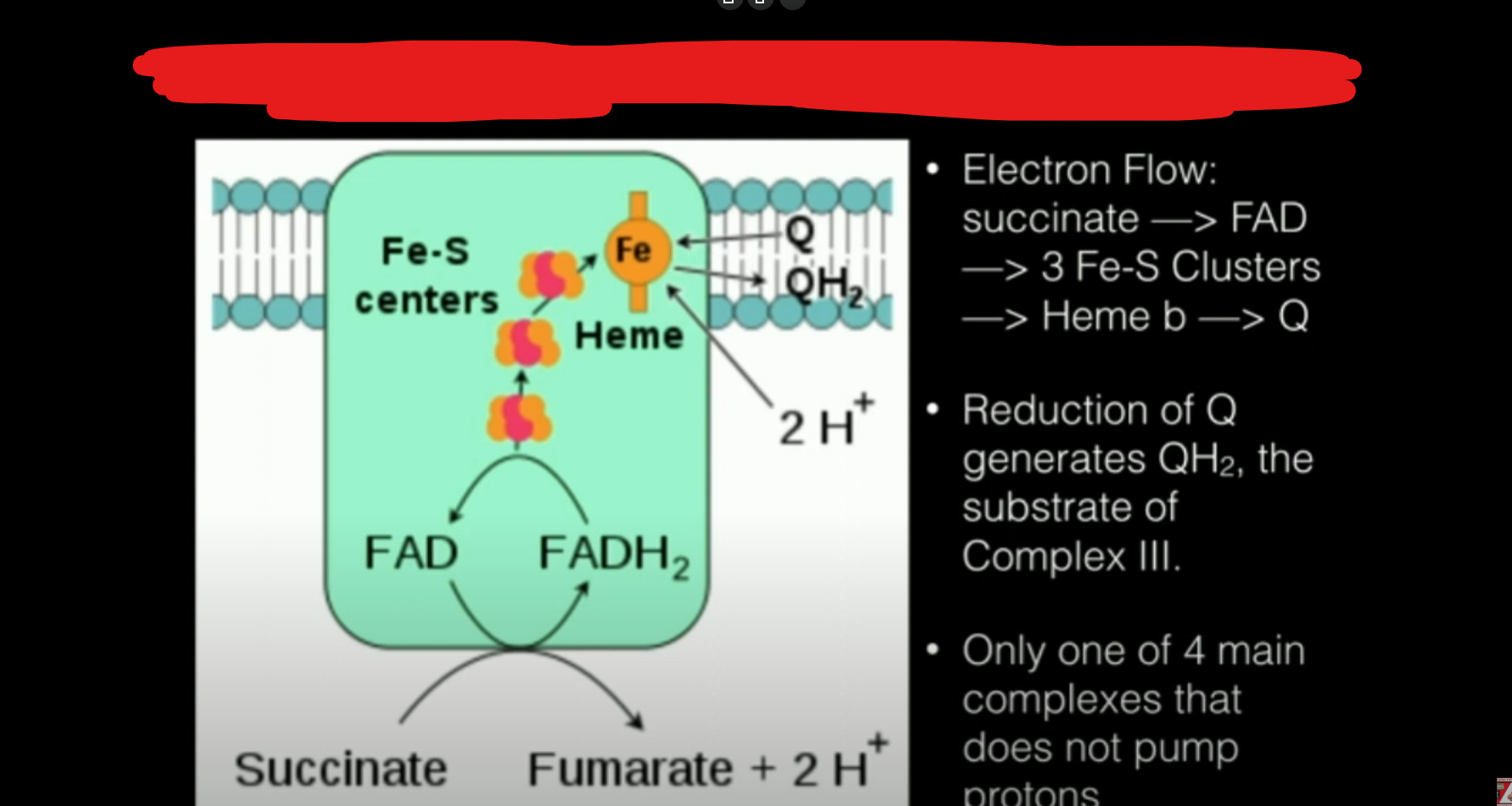
Ubiquinone
A small mobile carrier that accepts electrons from both complex 1 and 2 and transports them to 3.
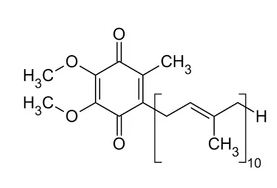
Flavoprotein
A molecule made up of polypeptides and with a flavin mononucleotide molecule attached to it. This molecule is present in Complex 1 in the electron transport chain.
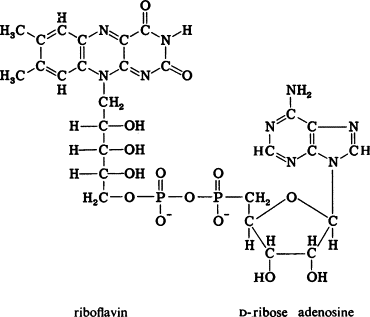
Cytochromes
A family of related proteins that have heme prosthetic groups containing iron ions which allow electrons to bind. Tasked with carrying electrons around complexes.
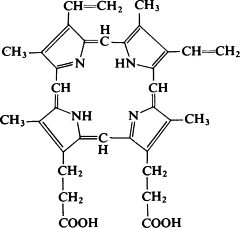
Cytochrome C
A small mobile carrier that accepts electrons from complex 3 and transfers them into complex 3.
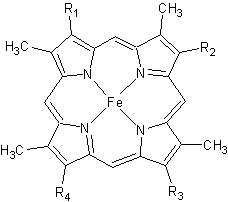
Complex 3: Cytochrome C Reductase
Contains Fe-S proteins and cytochromes. These send electrons to complex 4. In this complex electrons are passed from 1 cytochrome to an Fe-S protein to another cytochrome until they are transferred out of the complex to another mobile electron carrier (cytochrome C). This ____ also pumps proteins into the intermembrane space.
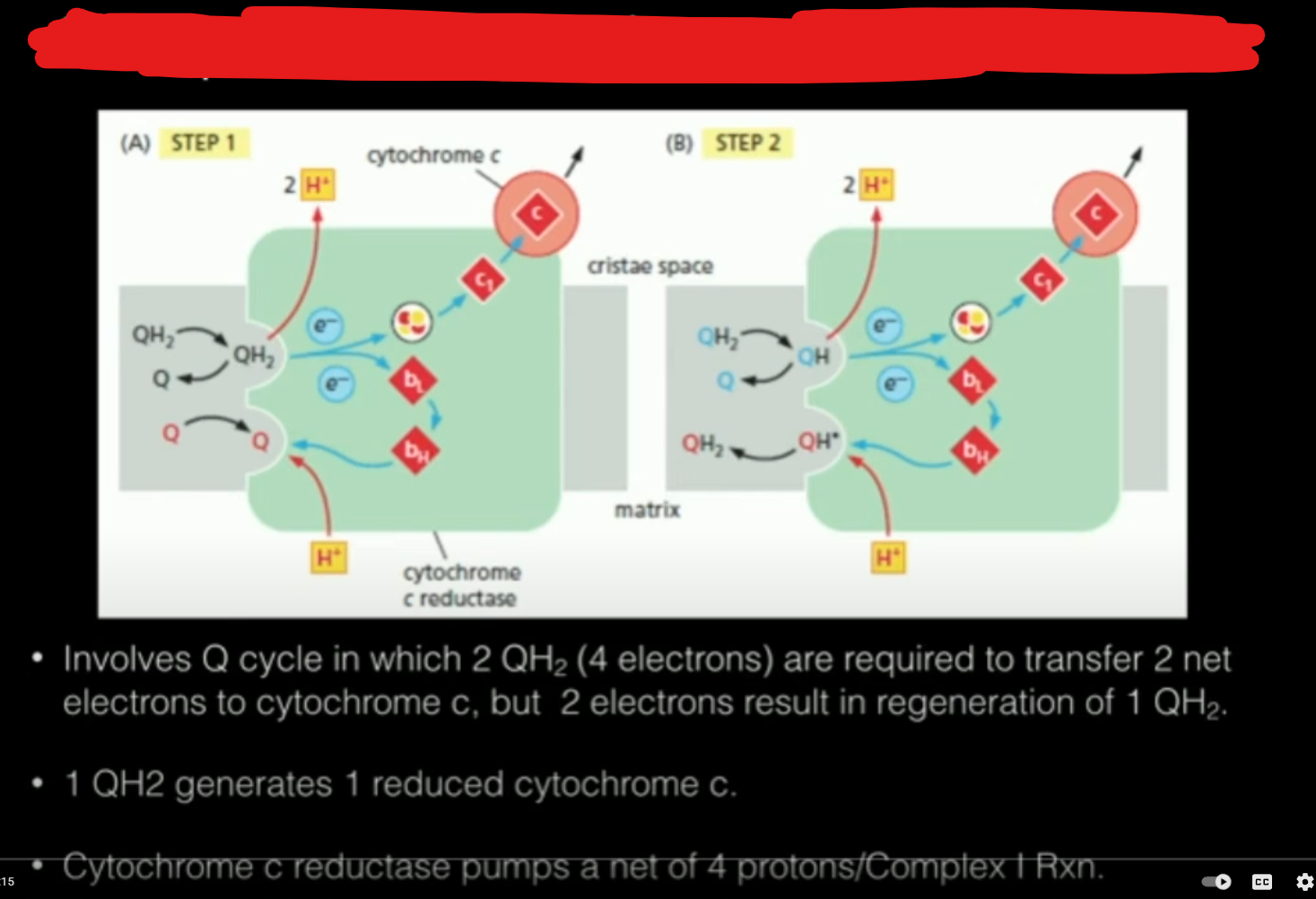
Complex 4: Cytochrome C Oxidase
Passes electrons received from complex 3 through 2 more cytochromes the second of which transfers electrons to O2 and forms 2H2O.
Pumps protons into intermembrane space
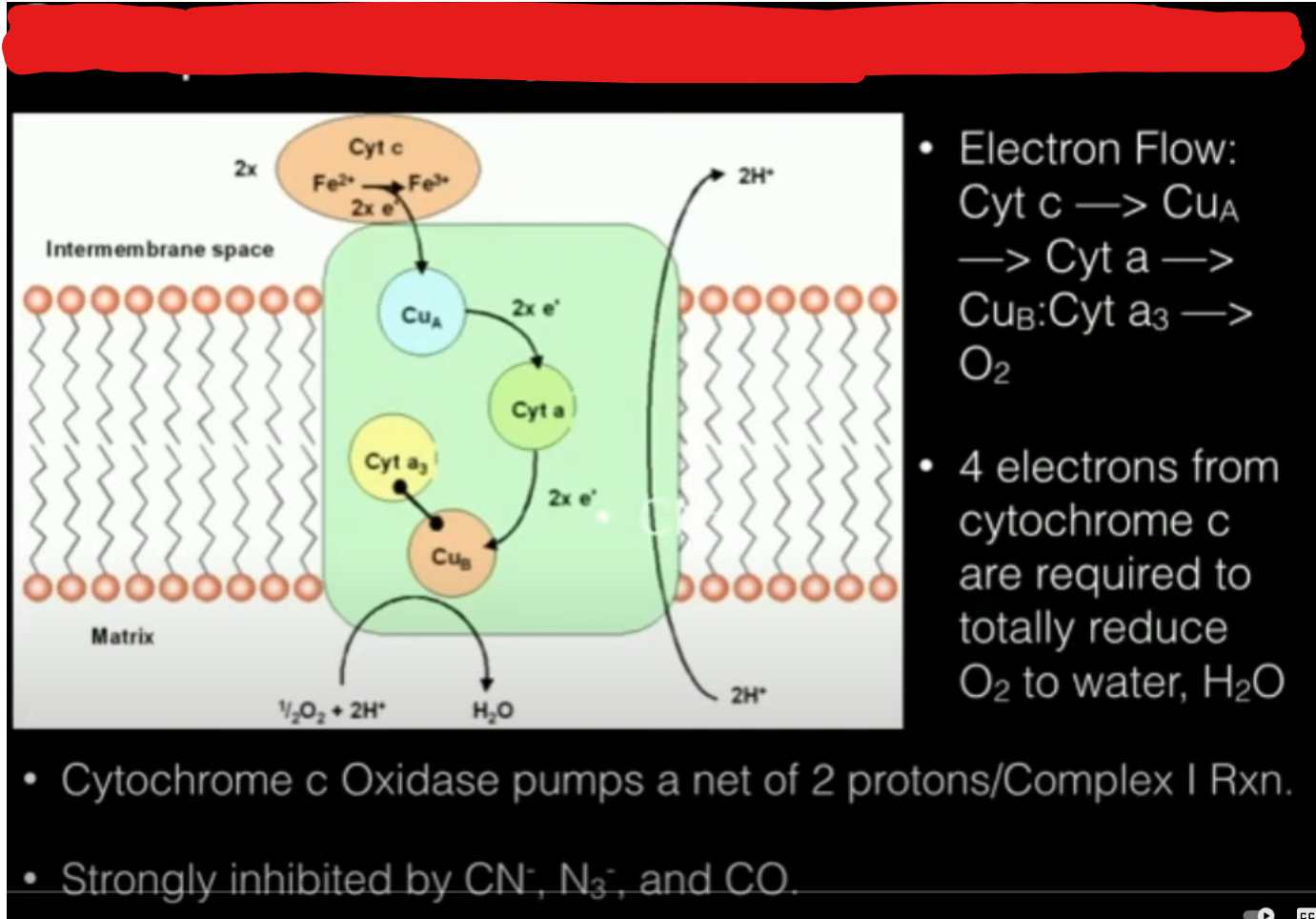
Anaerobic Cellular Respiration
Cellular respiration in which the final electron acceptors in the electron transport chain are not oxygen molecules.
Aerobic Cellular Respiration
Cellular respiration in which the final electron acceptors in the electron transport chain are oxygen molecules.
Lactic Acid Fermentation
The process of NADH transferring electrons directly to pyruvate thus generating lactate.
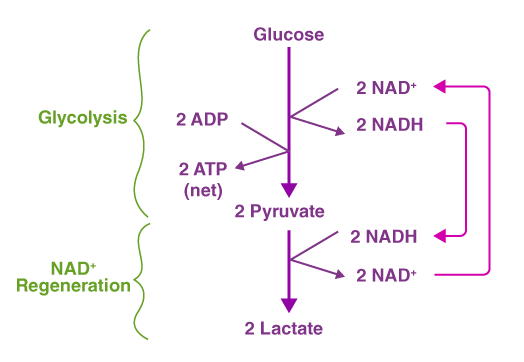
Alcohol Fermentation
NADH donating its electrons to a derivative of pyruvate, producing ethanol. In this process a carboxyl group is removed from pyruvate after which it turns into acetaldehyde and after accepting 2 electrons from NADH and turning it into NAD+ acetaldehyde turns into ethanol.
